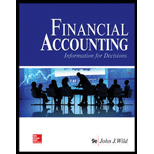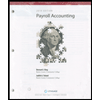
Loose Leaf for Financial Accounting: Information for Decisions
9th Edition
ISBN: 9781260158762
Author: John J Wild
Publisher: McGraw-Hill Education
expand_more
expand_more
format_list_bulleted
Concept explainers
Question
Chapter 1, Problem 12E
Summary Introduction
Concept Introduction:
Accounting equation is a mathematical representation of the relation between assets, liabilities, and equity. According to this relation, the total assets are equal to the sum of liabilities and equity.
To identify: The effect of the transaction on the accounting equation.
Expert Solution & Answer
Want to see the full answer?
Check out a sample textbook solution
Students have asked these similar questions
Kindly help me with this General accounting questions not use chart gpt please fast given solution
Please provide the accurate answer to this accounting problem using appropriate methods.
Financial accounting
Chapter 1 Solutions
Loose Leaf for Financial Accounting: Information for Decisions
Ch. 1 - Prob. 1DQCh. 1 - Technology is increasingly used to process...Ch. 1 - Identify four kinds of external users and describe...Ch. 1 - What are at least three questions business owners...Ch. 1 - Prob. 5DQCh. 1 - Describe the internal role of accounting for...Ch. 1 - Identify three types of services typically offered...Ch. 1 - Prob. 8DQCh. 1 - Why is accounting described as a service activity?Ch. 1 - What are some accounting-related professions?
Ch. 1 - Prob. 11DQCh. 1 - Prob. 12DQCh. 1 - What does the concept of objectivity imply for...Ch. 1 - Prob. 14DQCh. 1 - Prob. 15DQCh. 1 - Prob. 16DQCh. 1 - Define (a) assets, (b) liabilities, (c) equity,...Ch. 1 - Prob. 18DQCh. 1 - Prob. 19DQCh. 1 - What do accountants mean by the term revenue?Ch. 1 - Prob. 21DQCh. 1 - Prob. 22DQCh. 1 - Prob. 23DQCh. 1 - Prob. 24DQCh. 1 - Prob. 25DQCh. 1 - Prob. 26DQCh. 1 - Prob. 27DQCh. 1 - Define and explain return on assets.Ch. 1 - Define return and risk. Discuss the trade-off...Ch. 1 - Prob. 30DQCh. 1 - Prob. 31DQCh. 1 - Prob. 32DQCh. 1 - Choose from the following term or phrase a through...Ch. 1 - Prob. 2QSCh. 1 - Prob. 3QSCh. 1 - Identify each of the following terms or phrases as...Ch. 1 - Prob. 5QSCh. 1 - Prob. 6QSCh. 1 - Prob. 7QSCh. 1 - Prob. 8QSCh. 1 - Use Google's December 31. 2016, financial...Ch. 1 - Prob. 10QSCh. 1 - Prob. 11QSCh. 1 - Prob. 12QSCh. 1 - Prob. 13QSCh. 1 - Prob. 14QSCh. 1 - Prob. 15QSCh. 1 - Prob. 16QSCh. 1 - Prob. 17QSCh. 1 - Prob. 1ECh. 1 - Prob. 2ECh. 1 - Prob. 3ECh. 1 - Match each of the numbered descriptions I through...Ch. 1 - Prob. 5ECh. 1 - Enter the letter A through H for the principle or...Ch. 1 - Determine the missing amount from each of the...Ch. 1 - Prob. 10ECh. 1 - Prob. 11ECh. 1 - Prob. 12ECh. 1 - Prob. 13ECh. 1 - Prob. 14ECh. 1 - Prob. 15ECh. 1 - Use the information in Exercise 1-15 to prepare an...Ch. 1 - Prob. 17ECh. 1 - Prob. 18ECh. 1 - Prob. 19ECh. 1 - Prob. 20ECh. 1 - Prob. 21ECh. 1 - Prob. 22ECh. 1 - Prob. 23ECh. 1 - Identify how each of the following separate...Ch. 1 - Prob. 2PSACh. 1 - Prob. 3PSACh. 1 - Prob. 4PSACh. 1 - Prob. 5PSACh. 1 - Prob. 6PSACh. 1 - Gabi Gram started The Gram Co., a new business...Ch. 1 - Prob. 8PSACh. 1 - Sanyu Sony started a new business and completed...Ch. 1 - Prob. 10PSACh. 1 - Prob. 11PSACh. 1 - Prob. 12PSACh. 1 - Prob. 13PSACh. 1 - Prob. 14PSACh. 1 - Prob. 1PSBCh. 1 - Prob. 2PSBCh. 1 - Prob. 3PSBCh. 1 - Prob. 4PSBCh. 1 - Prob. 5PSBCh. 1 - Prob. 6PSBCh. 1 - Prob. 7PSBCh. 1 - Prob. 8PSBCh. 1 - Prob. 9PSBCh. 1 - Prob. 10PSBCh. 1 - Prob. 11PSBCh. 1 - Prob. 12PSBCh. 1 - Prob. 13PSBCh. 1 - Prob. 14PSBCh. 1 - On October 1, 2018, Santana Rey launched a...Ch. 1 - Prob. 1FSACh. 1 - comparative figures ($ millions) for both Apple...Ch. 1 - Prob. 3FSACh. 1 - Prob. 1BTNCh. 1 - Prob. 2BTNCh. 1 - Prob. 4BTNCh. 1 - Prob. 5BTNCh. 1 - Prob. 6BTN
Knowledge Booster
Learn more about
Need a deep-dive on the concept behind this application? Look no further. Learn more about this topic, accounting and related others by exploring similar questions and additional content below.Similar questions
- Can you solve this general accounting question with the appropriate accounting analysis techniques?arrow_forwardPlease help me solve this general accounting question using the right accounting principles.arrow_forwardCan you explain this financial accounting question using accurate calculation methods?arrow_forward
- I just need help with Required #5: On May 1, 2024, Hecala Mining entered into an agreement with the state of New Mexico to obtain the rights to operate a mineral mine in New Mexico for $10 million. Additional costs and purchases included the following: Note: Use tables, Excel, or a financial calculator. (FV of $1, PV of $1, FVA of $1, PVA of $1, FVAD of $1 and PVAD of $1) Development costs in preparing the mine $ 3,200,000 Mining equipment 140,000 Construction of various structures on site 68,000 After the minerals are removed from the mine, the equipment will be sold for an estimated residual value of $10,000. The structures will be torn down. Geologists estimate that 800,000 tons of ore can be extracted from the mine. After the ore is removed, the land will revert back to the state of New Mexico. The contract with the state requires Hecala to restore the land to its original condition after mining operations are completed in approximately four years. Management has…arrow_forwardPlease given correct answer for General accounting question I need step by step explanationarrow_forwardCan you explain the correct methodology to solve this general accounting problem?arrow_forward
arrow_back_ios
SEE MORE QUESTIONS
arrow_forward_ios
Recommended textbooks for you
 College Accounting, Chapters 1-27AccountingISBN:9781337794756Author:HEINTZ, James A.Publisher:Cengage Learning,
College Accounting, Chapters 1-27AccountingISBN:9781337794756Author:HEINTZ, James A.Publisher:Cengage Learning, Cornerstones of Financial AccountingAccountingISBN:9781337690881Author:Jay Rich, Jeff JonesPublisher:Cengage Learning
Cornerstones of Financial AccountingAccountingISBN:9781337690881Author:Jay Rich, Jeff JonesPublisher:Cengage Learning
- Principles of Accounting Volume 1AccountingISBN:9781947172685Author:OpenStaxPublisher:OpenStax College
 College Accounting (Book Only): A Career ApproachAccountingISBN:9781337280570Author:Scott, Cathy J.Publisher:South-Western College Pub
College Accounting (Book Only): A Career ApproachAccountingISBN:9781337280570Author:Scott, Cathy J.Publisher:South-Western College Pub

College Accounting, Chapters 1-27
Accounting
ISBN:9781337794756
Author:HEINTZ, James A.
Publisher:Cengage Learning,

Cornerstones of Financial Accounting
Accounting
ISBN:9781337690881
Author:Jay Rich, Jeff Jones
Publisher:Cengage Learning


Principles of Accounting Volume 1
Accounting
ISBN:9781947172685
Author:OpenStax
Publisher:OpenStax College

College Accounting (Book Only): A Career Approach
Accounting
ISBN:9781337280570
Author:Scott, Cathy J.
Publisher:South-Western College Pub

The ACCOUNTING EQUATION For BEGINNERS; Author: Accounting Stuff;https://www.youtube.com/watch?v=56xscQ4viWE;License: Standard Youtube License